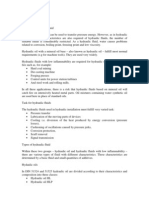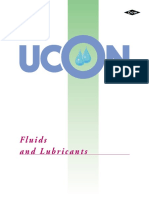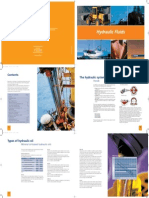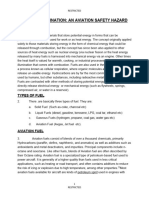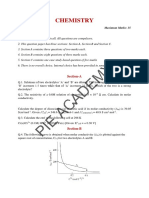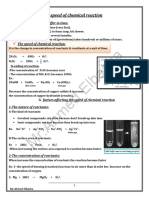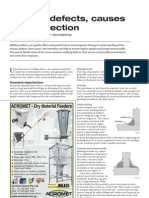0 ratings0% found this document useful (0 votes)
18 viewsHydraulic Oils
Hydraulic Oils
Uploaded by
christodoulos charalambousHydraulic oils are liquids, typically mineral oil-based, that are used to transfer power in hydraulic systems. They allow hydraulic machinery like backhoes, brakes, aircraft controls, and industrial equipment to function efficiently by having properties like low compressibility, thermal stability, lubrication, and viscosity control. Hydraulic oils convey power within systems while also protecting components from wear, transferring heat, and acting as a seal and lubricant. Special care and fluids are required for aircraft hydraulics due to safety critical applications.
Copyright:
© All Rights Reserved
Available Formats
Download as PDF, TXT or read online from Scribd
Hydraulic Oils
Hydraulic Oils
Uploaded by
christodoulos charalambous0 ratings0% found this document useful (0 votes)
18 views16 pagesHydraulic oils are liquids, typically mineral oil-based, that are used to transfer power in hydraulic systems. They allow hydraulic machinery like backhoes, brakes, aircraft controls, and industrial equipment to function efficiently by having properties like low compressibility, thermal stability, lubrication, and viscosity control. Hydraulic oils convey power within systems while also protecting components from wear, transferring heat, and acting as a seal and lubricant. Special care and fluids are required for aircraft hydraulics due to safety critical applications.
Original Description:
hydraulic oil
Original Title
a7e76d7f-1cc6-48c6-8977-b90f69118771-151124085226-lva1-app6892
Copyright
© © All Rights Reserved
Available Formats
PDF, TXT or read online from Scribd
Share this document
Did you find this document useful?
Is this content inappropriate?
Hydraulic oils are liquids, typically mineral oil-based, that are used to transfer power in hydraulic systems. They allow hydraulic machinery like backhoes, brakes, aircraft controls, and industrial equipment to function efficiently by having properties like low compressibility, thermal stability, lubrication, and viscosity control. Hydraulic oils convey power within systems while also protecting components from wear, transferring heat, and acting as a seal and lubricant. Special care and fluids are required for aircraft hydraulics due to safety critical applications.
Copyright:
© All Rights Reserved
Available Formats
Download as PDF, TXT or read online from Scribd
Download as pdf or txt
0 ratings0% found this document useful (0 votes)
18 views16 pagesHydraulic Oils
Hydraulic Oils
Uploaded by
christodoulos charalambousHydraulic oils are liquids, typically mineral oil-based, that are used to transfer power in hydraulic systems. They allow hydraulic machinery like backhoes, brakes, aircraft controls, and industrial equipment to function efficiently by having properties like low compressibility, thermal stability, lubrication, and viscosity control. Hydraulic oils convey power within systems while also protecting components from wear, transferring heat, and acting as a seal and lubricant. Special care and fluids are required for aircraft hydraulics due to safety critical applications.
Copyright:
© All Rights Reserved
Available Formats
Download as PDF, TXT or read online from Scribd
Download as pdf or txt
You are on page 1of 16
HYDRAULIC OILS
What are hydraulic oils???
They are the medium by which power is
transferred in hydraulic machinery
.
A liquid such as oil or water that is used
to generate power in a hydraulic system.
Examples of equipment that might use
hydraulic oils include and backhoes,
brakes, power steering systems,
transmissions, aircraft flight control
systems, elevators and industrial
machinery.
Hydraulic systems like the ones
mentioned above will work most
efficiently if the hydraulic fluid used has
low compressibility.
Characteristics and properties
Low temperature sensitivity of
viscosity;
Thermal and chemical stability;
Low compressibility;
Good lubrication (anti-wear and anti-
stick properties, low coefficient of
friction);
Hydrolytic stability (ability to retain
properties in the high humidity
environment);
Low pour point (the lowest
temperature, at which the oil may
flow);
Water emulsifying ability;
Filterability;
Rust and oxidation protection
properties;
Low flash point(the lowest temperature,
at which the oil vapors are ignitable);
Resistance to cavitations;
Low foaming;
Compatibility with sealant materials.
FUNCTIONS
The primary function of a hydraulic fluid
is to convey power.
Protection of the hydraulic machine
components.
Heat transfer
Sealing medium
Lubricant
COMPOSITION
Base Stock
The original hydraulic fluid, dating back
to the time of ancient Egypt, was water.
Beginning in the 1920s, mineral oil
began to be used more than water as a
base stock due to its inherent lubrication
properties and ability to be used at
temperatures above the bp of water.
Today most hydraulic fluids are based
on mineral oil base stocks.
Natural oils such as rapeseed used as
base stocks for fluids where
biodegradability and renewable sources
are considered important.
Other base stocks are used for specialty
applications, such as for fire resistance
and extreme temperature applications.
Some examples include: glycol, esters,
organophosphate ester, polyalphaolefin,
propylene glycol, and silicone oils.
Biodegradable hydraulic
fluids
Environmentally sensitive applications may
benefit from using biodegradable hydraulic
fluids based upon rapeseed, vegetable oil
when there is the risk of an oil spill from a
ruptured oil line. Typically these oils are
available as ISO 32, ISO 46, and ISO 68
specification oils. Guide for Assessing
Biodegradability of Hydraulic Fluids
Standard Classification of Hydraulic Fluids
for Environmental Impact are relevant.
Contamination
Special, stringent care is required when
handling aircraft hydraulic fluid as it is
critical to flight safety that it stay free
from contamination. It is also necessary
to strictly adhere to authorized
references when servicing or repairing
any aircraft system. Samples from
aircraft hydraulic systems are taken
during heavy aircraft maintenance
checks to check contamination.
Safety
Because industrial hydraulic systems
operate at hundreds to thousands of PSI
and temperatures reaching hundreds of
degrees Celsius, severe injuries and
death can result from component
failures and care must always be taken
when performing maintenance on
hydraulic systems.
Fire resistance is a property available
with specialized fluids.
ADVANTAGES
Higher efficiency
Better performance
Environment friendly
Can be used at very extreme
temperatures
Also works as lubricant while
transmitting power
Higher heat transfer capability than
water
Also acts as a sealing medium
No wear as the working parts are not in
contact.
DISADVANTAGES
A constant high pressure is required to
be maintained.
Leakage may occur.
Aeration may occur through the pump
causing noisy operation, power lag,
knocking etc.
Thank you
You might also like
- Bomag BW55E User Manual PDFDocument61 pagesBomag BW55E User Manual PDFchristodoulos charalambous50% (2)
- Chapter - 2 Hydraulic FluidDocument7 pagesChapter - 2 Hydraulic FluidPham Thị Thuy HaNo ratings yet
- How Industrial Businesses Can Reduce Production Costs With Reverse Osmosis: Industrial Reverse OsmosisFrom EverandHow Industrial Businesses Can Reduce Production Costs With Reverse Osmosis: Industrial Reverse OsmosisRating: 5 out of 5 stars5/5 (1)
- Hydraulic FluidDocument7 pagesHydraulic FluidAssassin's j :uNo ratings yet
- Hydraulic Fluid PDFDocument6 pagesHydraulic Fluid PDFSarah HayesNo ratings yet
- Hydraulic FluidDocument6 pagesHydraulic FluidDesiree Cena CapunoNo ratings yet
- Chap 4 Components of A Hydraulic SystemDocument57 pagesChap 4 Components of A Hydraulic SystemHarikrishna KanthavealNo ratings yet
- Hydraulic OilDocument7 pagesHydraulic OilAdelina MaicanNo ratings yet
- Shell Fire Resistant Fluids Hydraulic Fluids WhitepaperDocument3 pagesShell Fire Resistant Fluids Hydraulic Fluids WhitepapernghiaNo ratings yet
- Hydraulic Principles (Reading)Document2 pagesHydraulic Principles (Reading)KayamiroNo ratings yet
- 1.what Is A Fluid? What Are The Functions and Characteristics of Hydraulic FluidsDocument3 pages1.what Is A Fluid? What Are The Functions and Characteristics of Hydraulic FluidsjtorerocNo ratings yet
- FluidsDocument10 pagesFluidspcnishantNo ratings yet
- EU 0827 Hydraulic Oil FAQDocument1 pageEU 0827 Hydraulic Oil FAQOcto Adhi W PryhantoNo ratings yet
- HTTP WWW - Hydraulicspneumatics.com Classes Article Article Draw P1Document4 pagesHTTP WWW - Hydraulicspneumatics.com Classes Article Article Draw P1jorsueNo ratings yet
- 3 1 Hydraulic Fluids Functions Characteristics CategoriesDocument3 pages3 1 Hydraulic Fluids Functions Characteristics CategoriesMohamed SokarNo ratings yet
- University Teaching Department Rajasthan Technical University, KotaDocument29 pagesUniversity Teaching Department Rajasthan Technical University, Kotavershakhemka7193No ratings yet
- FluidsDocument20 pagesFluidsJhon Arreaga AguilarNo ratings yet
- 0901b8038003a7af PDFDocument47 pages0901b8038003a7af PDFshrikantNo ratings yet
- Non-Petroleum Hydraulic FluidsDocument3 pagesNon-Petroleum Hydraulic FluidsRueben RajNo ratings yet
- Get The Most of Heat Transfer SystemsDocument7 pagesGet The Most of Heat Transfer SystemsEvert AlexNo ratings yet
- Hydraulic SystemDocument263 pagesHydraulic Systemcarolynkiruba2005No ratings yet
- SAEA1303Document65 pagesSAEA1303Jashuva JoNo ratings yet
- Hydraulic Oil & SealsDocument98 pagesHydraulic Oil & Sealsppritamddaw100% (2)
- Volume6 Hydraulic Seals Fluid Conductor and Hydraulic OilDocument64 pagesVolume6 Hydraulic Seals Fluid Conductor and Hydraulic Oillink2u_007100% (1)
- Chapter # O1: 1.1) Hydraulic FluidDocument9 pagesChapter # O1: 1.1) Hydraulic FluidUmar DrazNo ratings yet
- Improving Rolling Mill Lube Oil PDFDocument4 pagesImproving Rolling Mill Lube Oil PDFRaj Kumar SinghNo ratings yet
- Avt 1212 Midterm Module 1Document20 pagesAvt 1212 Midterm Module 1Mariano MEL MATTHEW B.No ratings yet
- Types of Hydraulic FluidsDocument5 pagesTypes of Hydraulic FluidsRtfjrjgr Xefwwxebge XsjlkzxzlsjxsjNo ratings yet
- Basics of Rotary Screw Compressor Lubricants-Tcm67-319606 PDFDocument8 pagesBasics of Rotary Screw Compressor Lubricants-Tcm67-319606 PDFDarmawan Putranto100% (2)
- Hydraulic FluidsDocument2 pagesHydraulic FluidsKarthikeyan0% (1)
- Hydraulic Fluids FolderDocument14 pagesHydraulic Fluids FolderBashir Soliman100% (2)
- Ihp FullDocument7 pagesIhp Fullv.v.ransing22No ratings yet
- Hydrolic SystemDocument6 pagesHydrolic Systemthaerlaham2020No ratings yet
- Lubricating OilDocument24 pagesLubricating OilShyam YadavNo ratings yet
- Hydraulic OilsDocument50 pagesHydraulic OilsShivanshu BaranwalNo ratings yet
- Applications For Hydraulic FluidsDocument27 pagesApplications For Hydraulic Fluidsdanielr.hanna93No ratings yet
- 3.types of Fluids - Properties of Fluids and SelectionDocument3 pages3.types of Fluids - Properties of Fluids and SelectionAnya CooperNo ratings yet
- Hydraulic Fluid and Base Stock OptionsDocument3 pagesHydraulic Fluid and Base Stock OptionsHesham MahdyNo ratings yet
- Aircraft Hydraulic Systems-1Document54 pagesAircraft Hydraulic Systems-1Gabriel EstrellaNo ratings yet
- Lecture 1 - Fluid Power - An Introduction PDFDocument40 pagesLecture 1 - Fluid Power - An Introduction PDFbmdbmdbmd100% (1)
- Shell Hydraulic S1 M 68: Performance, Features & Benefits Specifications, Approvals & RecommendationsDocument3 pagesShell Hydraulic S1 M 68: Performance, Features & Benefits Specifications, Approvals & RecommendationsEmon GtNo ratings yet
- FL Meheran Fuel ContaminationDocument7 pagesFL Meheran Fuel ContaminationSälmän Md ÄhsänNo ratings yet
- Synthetic Oil in Air CompressorsDocument9 pagesSynthetic Oil in Air CompressorsDayo IdowuNo ratings yet
- What Is Lubricant OilDocument5 pagesWhat Is Lubricant OilAicel Mari Castor PortugalNo ratings yet
- Fire-Resistant Fluids: E-Books Download Weblog: Water Engineering WeblogDocument8 pagesFire-Resistant Fluids: E-Books Download Weblog: Water Engineering WeblogalbertofgvNo ratings yet
- USL Fluid 101 EbookDocument8 pagesUSL Fluid 101 EbookWilliam NasserNo ratings yet
- itr1Document13 pagesitr1CHE21PRIYANSHI YADAVNo ratings yet
- Hydraulics and Pnuematics Unit No 01Document81 pagesHydraulics and Pnuematics Unit No 01Temesgen Erena100% (1)
- Di̇zel MotorlarDocument8 pagesDi̇zel MotorlarhuseynseymenNo ratings yet
- Hudraulic FliudsDocument19 pagesHudraulic Fliudsmohamed elejmiNo ratings yet
- Hydraulic Fluid Purpose & Properties: (Chapter 2)Document29 pagesHydraulic Fluid Purpose & Properties: (Chapter 2)christodoulos charalambousNo ratings yet
- Information On Hydraulic LiquidsDocument3 pagesInformation On Hydraulic LiquidsSeyed Ali TabatabaeeNo ratings yet
- Mild Steel Is A Type ofDocument4 pagesMild Steel Is A Type ofmanojpro21_913191197No ratings yet
- How To Select and Service A Turbine OilDocument8 pagesHow To Select and Service A Turbine Oildaniel adam100% (3)
- Introduction To Fluid Power Systems (FPS) TopicsDocument14 pagesIntroduction To Fluid Power Systems (FPS) TopicsRajath UpadhyaNo ratings yet
- Shell Thermia BDocument2 pagesShell Thermia Bsegunoyes100% (1)
- Of Hydraulic: TypesDocument6 pagesOf Hydraulic: TypesGayan Aravinda AbeygunawardaneNo ratings yet
- Machinery Oil Analysis & Condition Monitoring : A Practical Guide to Sampling and Analyzing Oil to Improve Equipment ReliabilityFrom EverandMachinery Oil Analysis & Condition Monitoring : A Practical Guide to Sampling and Analyzing Oil to Improve Equipment ReliabilityRating: 3.5 out of 5 stars3.5/5 (5)
- Hydraulic and Lubrication Oil Filters: Filtration ProductsDocument12 pagesHydraulic and Lubrication Oil Filters: Filtration Productschristodoulos charalambousNo ratings yet
- Hydraulic Fluid Purpose & Properties: (Chapter 2)Document29 pagesHydraulic Fluid Purpose & Properties: (Chapter 2)christodoulos charalambousNo ratings yet
- Guide To Good Leak TestingDocument10 pagesGuide To Good Leak Testingchristodoulos charalambousNo ratings yet
- Importance of Fluid Cleanliness in HydraulicsDocument29 pagesImportance of Fluid Cleanliness in Hydraulicschristodoulos charalambousNo ratings yet
- Harsha FILTERS: Hydraulic & Lube Oil FiltersDocument3 pagesHarsha FILTERS: Hydraulic & Lube Oil Filterschristodoulos charalambousNo ratings yet
- ασκήσεις υδραυλικων λαδιουDocument160 pagesασκήσεις υδραυλικων λαδιουchristodoulos charalambousNo ratings yet
- 6.25 Composite Materials and Structures in Civil EngineeringDocument39 pages6.25 Composite Materials and Structures in Civil EngineeringTemesgen TakeleNo ratings yet
- Reconditioning of ValvesDocument6 pagesReconditioning of ValvesPaul PhiliphsNo ratings yet
- 111 PFQ Iv 2021Document2 pages111 PFQ Iv 2021MuhammadNurrahmanNo ratings yet
- 2 Parking Garage - Shotcrete - 1002Document1 page2 Parking Garage - Shotcrete - 1002VJ QatarNo ratings yet
- Fa034 - Astm e 1025Document5 pagesFa034 - Astm e 1025Nestor De Jesus Pico TorresNo ratings yet
- Assessment of Out-Of-Plane Failure of Non-Engineered Masonry Wall Due To Storm SurgesDocument7 pagesAssessment of Out-Of-Plane Failure of Non-Engineered Masonry Wall Due To Storm SurgesAdji SutamaNo ratings yet
- Electrochemistry TestDocument3 pagesElectrochemistry TesttusharNo ratings yet
- Structural and Physicochemical Characteristics of Tetrabutylammonium Tetrahalogenoferrates (Iii), ( (C H) N) (Febr CL)Document5 pagesStructural and Physicochemical Characteristics of Tetrabutylammonium Tetrahalogenoferrates (Iii), ( (C H) N) (Febr CL)basselNo ratings yet
- API RP 13C (ISO 13501) - Derrick Equipment CompanyDocument4 pagesAPI RP 13C (ISO 13501) - Derrick Equipment CompanyRai100% (1)
- Flexural Strength A Measure To Control QualityDocument12 pagesFlexural Strength A Measure To Control Quality2742481No ratings yet
- JKM570 590N 72HL4 BDV F7 enDocument2 pagesJKM570 590N 72HL4 BDV F7 enViệt Trung HồNo ratings yet
- 33 Adeline ST, Bass Hill - Structural Drawing R2Document12 pages33 Adeline ST, Bass Hill - Structural Drawing R2Rohan Dutt SharmaNo ratings yet
- Bill of MaterialsDocument57 pagesBill of MaterialsShady RainNo ratings yet
- Prep.3 Unit One Lesson Two 2019Document2 pagesPrep.3 Unit One Lesson Two 2019monaatta444No ratings yet
- Meditran SX Sae 15w 40 API CH 4Document1 pageMeditran SX Sae 15w 40 API CH 4Aam HudsonNo ratings yet
- Welding Defects, Causes and CorrectionsDocument3 pagesWelding Defects, Causes and CorrectionsBinh Pham100% (2)
- 0620 s21 QP 42Document16 pages0620 s21 QP 42Ali Muhammad KambaNo ratings yet
- Electronics - Q2 - Week1 - Answer SheetDocument1 pageElectronics - Q2 - Week1 - Answer SheetMelissa GagujasNo ratings yet
- Lecture 15 (TXE 417) 1Document7 pagesLecture 15 (TXE 417) 1Shamin Yasir NahiedNo ratings yet
- High Type BItuminous Pavement GROUP 3Document9 pagesHigh Type BItuminous Pavement GROUP 3Mlkhr lgndbNo ratings yet
- Electropure EDI Engr OEM Manual REV v3 3Document80 pagesElectropure EDI Engr OEM Manual REV v3 3Ron VillaNo ratings yet
- BOM of InsulationDocument6 pagesBOM of Insulationzakaria masud sonyNo ratings yet
- Nuclear Micro Batteries For MEMS DevicesDocument10 pagesNuclear Micro Batteries For MEMS DevicesPardha Saradhi DamarlaNo ratings yet
- Study of Insecticides and Pesticides in Vegetables ProjectDocument12 pagesStudy of Insecticides and Pesticides in Vegetables Projectkikure24No ratings yet
- Assignment 1 With SolutionDocument8 pagesAssignment 1 With SolutionFaryal BatoolNo ratings yet
- Intermolecular Forces - HWDocument13 pagesIntermolecular Forces - HWKarren Ferrer-Mora Handayan100% (1)
- Piping Mat Specs Line Class Index Hb-202Document6 pagesPiping Mat Specs Line Class Index Hb-202OswaldoDCBNo ratings yet
- ICoSITeR 2020 Rundown v3Document7 pagesICoSITeR 2020 Rundown v3Uzuraton KachiNo ratings yet


